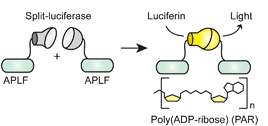Chemistry, Department of: Faculty Series
ORCID IDs
Document Type
Article
Date of this Version
2006
Abstract
Methodologies to detect DNA sequences with high sensitivity and specificity have tremendous potential as molecular diagnostic agents. Most current methods exploit the ability of single-stranded DNA (ssDNA) to base pair with high specificity to a complementary molecule. However, recent advances in robust techniques for recognition of DNA in the major and minor groove have made possible the direct detection of double-stranded DNA (dsDNA), without the need for denaturation, renaturation, or hybridization. This review will describe the progress in adapting polyamides, triplex DNA, and engineered zinc finger DNA-binding proteins as dsDNA diagnostic systems. In particular, the sequence-enabled reassembly (SEER) method, involving the use of custom zinc finger proteins, offers the potential for direct detection of dsDNA in cells, with implications for cell-based diagnostics and therapeutics.



Comments
Published in Molecular Biosystems 2:11 (November 2006), pp. 551-560; DOI: 10.1039/b611169f Copyright (c) Royal Society of Chemistry. Used by permission.